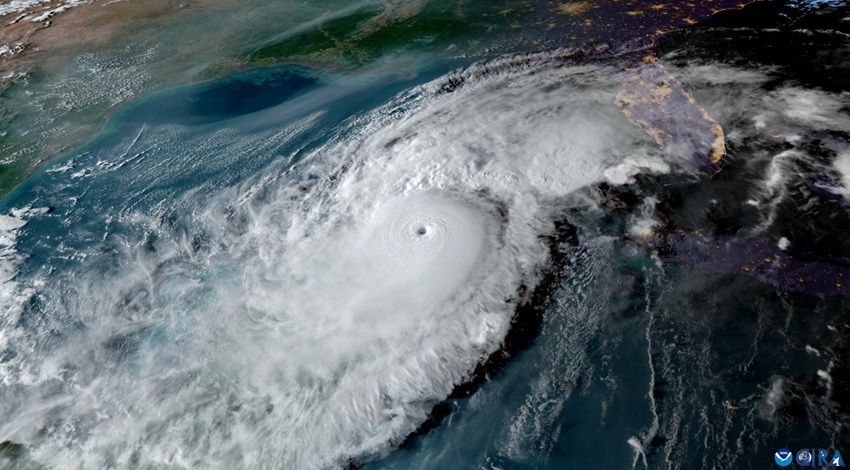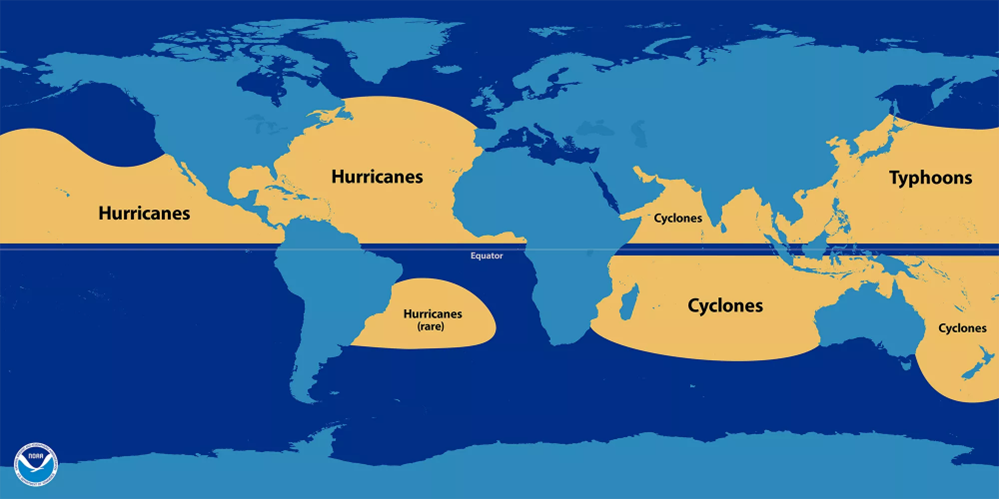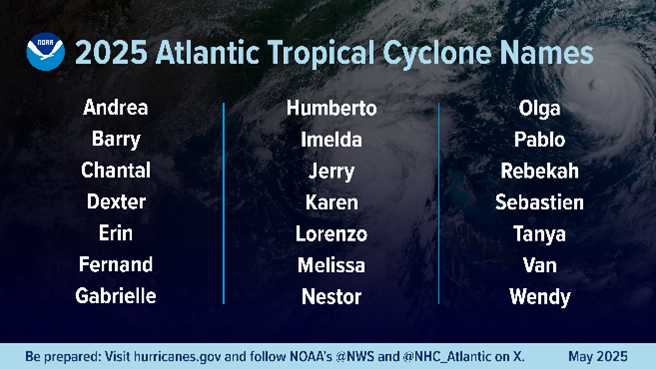June 1 Was the Start of Hurricane Season. Now is the Time to Prepare!

The National Oceanic and Atmospheric Administration (“NOAA”) forecasted in May for above-normal hurricane activity in the Atlantic basin this year. The season from June 1 to November 30, is predicted for a 30% chance of a near-normal season, a 60% chance of an above-normal season, and a 10% chance of a below-normal season. The forecast range of 13 to 19 total named storms (winds of 39 mph or higher). Of those, 6-10 are forecast to become hurricanes (winds of 74 mph or higher), including 3-5 major hurricanes (category 3, 4 or 5; with winds of 111 mph or higher). NOAA has a 70% confidence in these ranges.
Why is the season expected to be above normal?
The above normal forecast is due to a combination of factors that include continued ENSO-neutral conditions, (El Niño and La Niña, the natural climate pattern collectively known as ENSO,) warmer than average ocean temperatures, forecasts for weak wind shear, and the potential for higher activity from the West African Monsoon, a primary starting point for Atlantic hurricanes. All of these elements favor tropical storm formation.
The high activity era continues in the Atlantic Basin, featuring high-heat content in the ocean and reduced trade winds. The higher-heat content provides more energy to fuel storm development, while weaker winds allow the storms to develop without disruption. This hurricane season also has the potential for a northward shift of the West African monsoon, producing tropical waves that seed some of the strongest and most long-lived Atlantic storms.
What’s in a Name: Hurricanes, Cyclones and Typhoons
Meteorologists use the term “tropical cyclone” to describe storms around the world, but they are also referred to by a variety of regional names based on where they form.

- Hurricanes: North Atlantic and the eastern/central North Pacific oceans. It is extremely rare for one to form in the South Atlantic Ocean.
- Cyclones: western South Pacific and Indian oceans
- Typhoons: western North Pacific (around the Philippines, Japan, and China)
Hurricanes
The term "hurricane" came from the Caribbean, where the indigenous Taíno people of the Greater Antilles worshiped a storm deity named Juracán. This god’s name may have come from the Mayan god of wind, Huracan. Spanish explorers later adopted the words "huracán" and “furacán” to describe these intense storms and brought them to Europe. The word eventually came into the English language as European colonial powers expanded their territories and encountered these powerful storms in the Atlantic basin.
Cyclones
The word "cyclone" originated in ancient Greek, though sources disagree on exactly which term and is likely derived from either kúklos, “circle, wheel” or kuklóō, “go around in a circle, form a circle, encircle”- describing the spiraling nature of the storms. However, "cyclone" was a term used to describe any system characterized by circular motion, including tornadoes and whirlpools.
Typhoons
The word "typhoon" does not have a clear origin. It might have a Greek basis due to European influence, coming from the Greek word, Typhôn, who was a dangerous mythological monster associated with the power of the winds. Or the word may have had some influence on the Persian word, tūfīdan, which means “to roar or blow furiously.” Portuguese sailors traveling through this part of the world also brought back the word tufão. This comes from a root that is based in both Urdu and Hindi—tūfān—which may in turn be derived from an even older Chinese word, tai fung, meaning “great wind.” This word has since evolved to become dà fēng in modern Mandarin Chinese, and taifū in modern Japanese.
Since 1953, Atlantic tropical storms had been named from lists originated by the National Hurricane Center. They are now maintained and updated through a strict procedure by an international committee of the World Meteorological Organization, a specialized agency of the United Nations.

There are six lists that are used in rotation and re-cycled every six years, i.e., the 2023 list will be used again in 2029. The only time that there is a change in the list is if a storm is so deadly or costly that the future use of its name for a different storm would be inappropriate for reasons of sensitivity. If that occurs, then at an annual meeting by the WMO committee (called primarily to discuss many other issues) the offending name is stricken from the list and another name is selected to replace it. Several names have been retired since the lists were created.
Prepare Now, Don’t Wait!
If you live in the Gulf Coast, hurricanes are a part of life and having a plan in place will save you and your family a lot of aggravation and even lives.
The National Hurricane Center classifies hurricanes to their potential for producing damage on a scale of 1 to 5. Damage caused by a hurricane falls into 3 categories and is a result of one or a combination of “storm surge’, damaging winds, and excessive rainfall. “Storm surge", which is defined as an abnormal rise of sea water generated by a storm, over and above the predicted astronomical tides. This surge of water can exceed 20 feet in height depending upon the strength of the hurricane and tide conditions. Storm surge and flash flooding from excessive rain have caused more deaths than hurricane winds. A storm surge is not to be confused with a tidal wave or tsunami. The surge is a large amount of sea water with heavy wave action on top of it and can last for several hours. In a deep ocean, this huge dome of water sinks and flows away, but as the storm nears land the rising sea floor blocks the water's escape and comes ashore as a deadly flood. During high tide, the storm surge will be even deeper and more extensive.
Planning Ahead-TIPS
Before the Storm
Keep your vehicles fueled during hurricane season. Always have at least a half tank, and when a storm begins to threaten the Gulf, top your vehicles off to avoid local exhausted fuel supplies.
Prepare your home before hurricane season. The time to purchase lumber and cut and fit boards is before the necessary supplies are depleted from local home improvement stores.
Purchase and store your supplies (bottled water, non-perishable food, etc.) before the season begins.
Review your insurance coverage before the season begins. Ensure nothing has changed, and you are covered for damage associated with hurricanes. Review your requirement for wind and flood coverage. Most flood policies have a 30-day waiting period before kicking in so don't wait for an approaching storm before deciding to buy coverage.
Complete a property inventory before the season begins. Use a video camera and keep the tape or digital file in a safe location. Ensure you have appraisals for antiques and special items.
Survival Kit
- Kids activity kit- books, paper/crayons, favorite toy, pillow, etc.
- Pet kit- vaccination papers, leash/collar, pet food, medications, litter/pan
- Food-3-day supply of non-perishable food without needing refrigeration. Items needed for cooking, eating and cleaning
- Sanitary & Hygiene Needs-detergent, soap, paper towels/toilet paper, plastic garbage bags, etc.
- Communications, Lights, and Safety-Battery operated radio, cell phone/charger/battery, flashlights with extra batteries, waterproof matches/lighter
- Water-One gallon of water for each person per day plus for pets
- First Aid and Medical Supplies-first aid kit, prescription medications, etc.
Family Notification and Communication
- Designate someone outside the affected area as a central point of contact. Everyone in the family, wherever they are, must use the contact number to relay their condition, whereabouts, and personal messages.
- Everyone must memorize that number. For infants, toddlers, or special needs children, write the number visibly on what they are wearing.
- Teach everyone that will be using this number how to place a phone call without money (collect, phone card, etc.).
- In the event that you are separated from one another, have a regrouping location that is known to everyone
Stay Updated/Evacuate
In advance of Hurricane Season, identify several hotels within the designated area (located well inland and away from potential storm impacts) that meet the needs of you and your family, or in an area familiar to your family. Stay informed by local radio and TV broadcasts. Additional information and alert information can be found below. Stay safe.
More Information and Resources
Harris County
Texas Emergency Management
NOAA
- National Weather Service: www.weather.gov
- Live Hurricane Tracker: www.nesdis.noaa.gov
